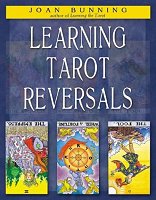|
Tarot Reflections |
|
February 1, 2004 |
| Book
Review: Learning Tarot Reversals Sandra Thomson, CTGM |
||||||
|
In one sense the book can be considered a companion to her earlier book Learning the Tarot. Each book has lessons with accompanying exercises, followed by a section on card meanings. There are eight chapters or lessons in Part 1, and each chapter contains a series of exercises, which build on each other. Together their focus is understanding card energy or energy cycles as expressed through the Tarot cards, and on energy expressions in your daily life. One of Bunning's purposes, as she writes in her introduction, is to "enhance the dynamic quality of your readings by seeing your cards as energies." For Bunning, tarot readings show not fixed forces, but, rather, ones that are fluid and dynamic. She wants to inspire you to recognize and attend to that energetic quality in your readings. Too often in the Little White Book (LWB) that accompanies a deck, we read that the reversed meaning of a card is its opposite. Bunning stresses this is not so. "An energy does not become its opposite when reversed," she writes. Rather, it shows that the energy is low, hidden, rejected, or ignored (Throw away your LWBs). If you get nothing else out of this book than that point, it is well worth the price-but, rest assured, there is much more "to get." In elaborating on her "low energy" idea, Bunning says, for instance, that a reversed World card does not show active unhappiness. Instead it indicates that the energy of happiness is low, whereas true unhappiness might appear in a reading designated by another card, say the Nine of Swords. The energy of a reversed card can be at a low or weak level because it's in the early part of a cycle or approaching the end of its cycle, so Bunning includes some exercises to give you experience in identifying where the energy might be in the cycle. Bunning believes that a cycle has three distinct phases: early, middle, and late. An upright card represents an energy in the strong, middle phase of its cycle. Reversed cards represent the early or late phase of a cycle. How to decide which takes some practice and experience, and to that end, Bunning has created exercises based on potential client statements and possible reversed cards to help you. She also provides exercises to learn to identify and work with repeating cycles. Other exercises include handling situations where you think or expect that one phase of energy is present, when, in actuality, it is another. Finally, in a series of exercises, Bunning teaches us that energies come in linked pairs; hence, so do tarot cards, i.e., two cards with opposite meanings. Want to know how to read them when they appear in a spread, both upright, both reversed, one upright, one reversed? Lesson Six is your tutor. Finally, Lesson Eight tells you how to put it all together. P.S. In an Appendix, Bunning provides possible responses (she emphasizes that they are not "answers") to some of the exercises in the first part of the book. It's like being at a workshop with Bunning. You can check yourself out with how the "expert" might respond. Part 2 covers the cards by giving a four- or five-sentence upright meaning, a series of short statements. Based on keywords in those statements, Bunning gives meanings when the card is reversed, in terms of whether it's "absent," in an "early phase," or in a "late phase." The exercises in Part 1 of the book help you determine how to "assign" these phases to the reversed card meaning, and there are plenty of options for everyone, and to cover every situation. At the very back of the book is a Keyword List, containing four or five keywords for each of the 78 cards. Do they match yours? Check it out. Pit yourself against the master. She certainly doesn't use some of the keywords I use for the Swords. Well, Joan, I suggest a Two of Swords duel at sunrise. Note I can suggest the Two of Swords because one of her keywords is "avoidance." You know I'm not gonna be there! Now, if she chooses an Eight of Wands ("quick action, conclusion"), I'm doomed. You will have to study this book, and do at least some of the exercises to successfully use its method for reading reversals. It will give you something to do while you're waiting for that mythical duel between Joan Bunning and me. By that time, you will have become a far better tarot reader than you were when first you picked up this book. And, isn't that what this whole tarot thing is all about? Learning Tarot Reversals (ISBN 1-57863-271-4) is a publication of Red Wheel/Weiser, and is available in bookstores. You can visit their website at RedWheelWeiser.com. |
|||||
|
Subscribe to Tarot Reflections, and receive notification of each update! |
|
Request to be added to the list by sending email to TarotReflections-subscribe@yahoogroups.com! |
All articles remain the
property of their respective authors.
Tarot Reflections is a publication of the American Tarot Association
- Copyright (C) 2004
Questions or Comments? Contact Us.


